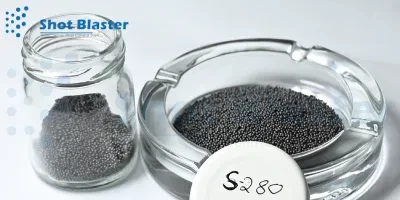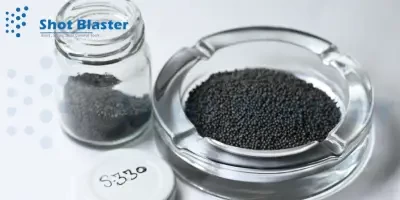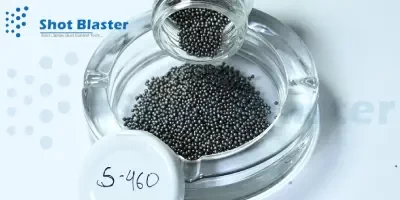Introduction Of Cast Steel Shot
Cast steel shot is created by melting steel and putting it into molds to form shot pellets. Cast steel shots are noted for its hardness & homogeneity, assembling it perfect for an assortment of applications such as shot blasting & peening.
Cast steel shot is assembled instantly from the liquid state. The technique utilized is the prime reason for size variability. Liquid steel is poured from a ladle into high-pressure jets of water. The water jets break up the steel stream into tiny droplets that solidify to become shot particles. Droplets strive to reduce exterior energy by minimizing the exterior area-to-volume ratio. A spherical shape maintains the shortest exterior area-to-volume ratio. Hence, as-cast shot particles approximate to spheres. Possible variations of shot particle sizes produced by one ladleful of steel. These are close to what is called “normal distributions”. The distribution has a mean that could be controlled, to a limited extent, by elements such as water jet pressure and geometry. Variations about the standard could be quantified by its variance value (square of standard deviation). Cast steel shot is used in shot blasting machine operation.
Cast Steel Shot Hardness
SAE grade cast steel shot is specified in four hardness ranges, with 90% of the sample within the range. S (41 to 51 HRC), M (47 to 56 HRC), L (54 to 61 HRC), and H (minimum 60 HRC). Cast steel shots that conform to AMS is specified in two ranges, AMS 2431/1 (45 to 52 HRC) and AMS 2431/2 (55 to 62 HRC). Steel shot that is too soft will not produce the required residual compressive stress as the particles themselves tend to absorb a large part of the kinetic energy. On the contrary, a shot that is very hard fractures faster, increasing the generation of fines & increased machine wear.
The cast steel shot microstructure should be such that it resists deformation upon impact. It must be free of brittle iron carbides that lead to premature shot fracture. Fractured particles could lead to nicks on the components when impacted, leading to potential stress risers. Tempered martensite is a preferred, fatigue-resistant microstructure desired in cast steel shot.
The mass/size variations comprise just a small consonance of the most commercially significant shot sizes (such as steel shot S110, S170, & S230). A grit fraction could go directly to crushing because the water-quenched state is absolutely brittle. Normally, however, the whole output is classified, then customized and quenched before rough screening to separate potential grit & shot fractions. The shot fraction is tempered & fine screened in order to yield distinct specification sizes of virgin shot. Cast steel shot/ steel grit is used for the abrasive blasting machine to remove exterior contaminants from the workpiece.
To avoid early coating failure, perfect cleanliness & the right profile must be maintained. A significant benefit of utilizing cast steel abrasives in the blast cleaning profiling process is that both may be completed in a single operation. The cast steel shot & steel grit, together with the work miu created, remove the impurity while also providing the anchor pattern. A technology has been generated for producing a new grade of steel shots employed in casting cleaning. The formulated technology is established on acquiring molten steel with the determined chemical composition micro-alloyed with titanium & utilizing an approvingly efficient methodology of dispersing molten steel stream by water jet underneath heightened pressure observed by periodization of produced particles & their solidification in a water bath. The chemical composition & tapping temperature have been accommodated & additional parameters of the atomization process such as molten stream nozzle internal diameter, impact angle, wet blasting nozzle system, and water pressure have been optimized to achieve steel shots with the desired mechanical properties, microstructure, density & grain size. After drying, the steel shots are filtered to distinct sizes. The preferred grain size is then subjected to just a one-step tempering process. This technique decreases the processing steps (by omission of the reheating-quenching treatment) & therefore presents considerable conservancies in processing cost.
Chemical Composition
| Carbon | 0.8-1.2% |
| Silicon | 0.4-1.2% |
| Manganese | 0.6-1.2% |
| Sulfur | 0.05% Max |
| Phosphorus | 0.05% Max |
Types of Cast Steel Shot
High Carbon Cast Steel Shot - General in a range of different hardness, this is the metallic medium most used for recirculatory blasting in both airless & pressure sand blasting machines.
Low Carbon Cast Steel Shot - A quieter shot than heightened carbon being suitable for all but the most severe applications. This material imparts a brighter finish with the benefits of longer life and reduced wear on the equipment in which it is used.
Cast Steel Shot Manufacturers
We are one of the most usable cast steel shot manufacturers and also cast steel shot suppliers in India with the best quality. Our cast steel shot price is low compared to other industries. We also offer steel shot, steel grit, stainless steel shot, chilled iron grit, stainless steel shot, glass beads, cut wire shots, etc.




